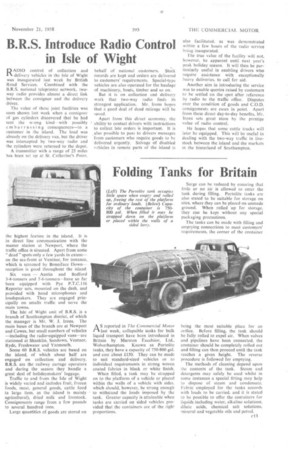Folding Tanks for Britain
Page 51

If you've noticed an error in this article please click here to report it so we can fix it.
the highest feature in the island. It is in direct line communication with the master station at Newport, where the traffic office is situated. Apart from some "dead" spots only a few yards in extent— on the sea-front at Ventnor, for instance, which is screened by Bonniface Down— reception is good throughout the island.
Six vans — Austin and Bedford 3-4-tonners and 5-6-tonners—have so far been equipped with Pye P.T.C.I 16 Reporter sets, mounted on the dash, and provided with hand microphones and loudspeakers. They are engaged principally on smalls traffic and serve the main towns.
The Isle of Wight unit of B.R.S. is a branch of Southampton district, of which the manager is Mr. W J. Irons. The main bases of the branch are at Newport and Cowes, but small numbers of vehicles —including the radio-equipped vans—are stationed at Shanklin, Sandown, Ventnor, Ryde, Freshwater and Yarmouth.
Some 60 B.R.S. vehicles are based on the island, of which about half are engaged on collection and delivery. B.R.S. are the railway cartage operators and during the season they handle a great deal of holidaymakers' luggage.
Traffic to and from the Isle of Wight is widely varied and includes fruit, frozen foods, meat, general goods, cattle food (a large item, as the island is mainly agricultural), dried milk and livestock, Consignments range from a few pounds to several hundred tons.
Large quantities of goods are stored on
A'reported in The Commercial Motor last week, collapsible tanks for bulk liquid transport have been introduced in Britain by Marston Excelsior, Ltd., Wolverhampton. Known as Portolite tanks, they have a capacity of 750-800 gal. and cost about £150. They can be made to suit standard-sized vehicles or to individual requirements in strong woven. coated fabrics in black or white finish.
When filled, a tank may be strapped on to the platform of a vehicle or placed within the walls of a vehicle with sides, which should, however, be strong enough to withstand the loads imposed by the tank. Greater capacity is attainable when tanks are carried on sided vehicles provided that the containers are of the right proportions. Surge can be reduced by ensuring that little or no air is allowed to enter the tank during filling. Portolite tanks are also stated to be suitable for storage on sites, where they can be placed on unmade ground. When rolled 'up for storage, they can be kept without any special packaging precautions.
The tanks can be made with tilling and emptying connections to meet customers' requirements, the corner of the container
being the most suitable place for an orifice. Before filling, the tank should be fully rolled to expel air. When valves and pipelines have been connected, the container should be completely rolled out and filling can then proceed until the tank reaches a given height. The reverse procedure is followed for emptying.
The methods of cleaning depend upon the contents of the tank. Steam and detergents may safely be used whilst in some instances a special fitting may help to dispose of steam and condensate. Fabric employed for the tanks accords with loads to be carried, and it is stated to be possible to offer the containers for liquids including water, alkaline solutions, dilute acids, chemical salt solutions, mineral and vegetable oils and petrol.












































































































